A method for designing a plastic that is comprised of RF sensitive monomers whereby they can react with specifically tuned RF fields to de-polymerize thus converting the polymer into its monomer components.
Plastics are known for their extremely useful properties and have invoked a materials revolution since it's creation. Durable, watertight, light weight & easily manufactured, plastics have become ubiquitous in our modern world. However, on the down side, plastics are too perfect and long lasting, the disposable of which has become an issue of world wide, environmental, concern.
Current methods of handling plastic waste include recycling, re-purposing, land filling, incineration, sublimation, bio-degradation/digestion, temporal degradation, photo degradation & conversion via chemical (including enzymatic) reaction. Each method has it's advantages and disadvantages, some creating dangerous byproducts including greenhouse gases, others being difficult and/or expensive to implement.
This new method addresses the plastic manufacturing process, directly, by integrating a unique disposal technique into the final product. This technique is based on the 2 step application of specific radio frequency energy to polymers comprised of monomers with RF-sensitive functional groups. This is analogous to the application of microwave energy to water-containing foods to generate heat via molecular excitation, the difference being that this method utilizes similar action to facilitate separation.
This method addresses concerns where other methods (namely bio, photo, atmospheric & temporal degradation) are inadequate regarding unknowns such as longevity, durability and decomposition rates. With this method, decomposition is forced via RF action when and where it is required.
Manufacturing:
For manufacturing, current manufacturing techniques would apply, and, with the exception of determining functional chemistry, should not require exotic nor complex processes as all the technology is already in place making adaptation considerably easier.
Process:
This 2 step process of RF degradation occurs as follows:
1) Exposing the polymer to RF energy of a specific wavelength such that functional groups respond with intense vibration, effectively "loosening" molecular bonds without complete dissociation - a reversible process. This puts the polymer in a flux and primes it for the next step.
2) With the polymer in flux (still exposed to RF - we'll refer to as RF#1), an additional exposure of the polymer to an alternate wavelength of RF energy proceeds.
This finalizes the breakdown of the polymer to it's monomer components - a non-reversible process.
Refer to functional diagram.
Considerations:
The monomer chemistry must be such that, by itself, it is harmless to the environment.
The polymers synthesized must have similar properties to existing plastics.
The polymers synthesized must not be toxic nor leach toxins into the environment nor matter it comes in contact with.
The energy provided for RF transmission should come from renewable sources.
Scaling Technology:
While it may be more efficient to RF degrade plastic at an industrial scale, this method is easily scalable down to a domestic use technology (size of a trash compactor) with the safety equivalent of a microwave oven. Degrading your plastic at home may become commonplace with this technology as recycling already is.
Like this entry?
-
About the Entrant
- Name:Jon Nuss
- Type of entry:individual
- Patent status:none

